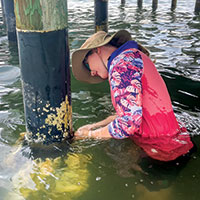 County ready to turn your dock’s pilings into a living reef
County ready to turn your dock’s pilings into a living reef
STORY BY JON PINE (Week of June 26, 2025)
How would you like to have a thriving reef just outside your door that was literally breathing new life into a waterway? What if it was free?
If you have a home on the Indian River Lagoon or water that leads to it, you may qualify for an innovative county program that will turn your dock’s pilings into a living reef that will clean thousands of gallons of water daily and attract everything from crabs and shrimp to tarpon and dolphins.
The county’s Living Docks program was launched last November in collaboration with the Florida Institute of Technology’s Indian River Lagoon Research Institute, and the county is looking for homeowners on the island and mainland who want to be part of it.
The science behind Living Docks is surprisingly simple: Wrapping a dock’s pilings below the water with mats adorned with dried oyster shells will attract live oysters, barnacles and a wide variety of other marine animals, including tunicates such as sea squirts, sea pork and sea tulips that can filter pollutants and microplastics out of 20 gallons of water per day. Oysters can filter up to 50 gallons a day.
So far, county staff have wrapped pilings on docks in Orchid and Seagrove West on the barrier island.
One of the docks is owned by Craig Walker, whose home is on the lagoon in Seagrove. Walker, a volunteer with ORCA – the Ocean Research and Conservation Association – read about the program on Facebook and jumped at the chance to participate.
“Anything you can do to try to help clean up the lagoon is a good thing,” Walker said. County staff wrapped about 30 pilings on his dock earlier this spring. Within a few weeks, oyster spats took hold. “Obviously, oysters are a really good filter mechanisms, so getting them to colonize is all good,” he said.
These organisms are the “livers and kidneys of the ecosystem, the filter feeders,” says Dr. Robert Weaver, an associate professor at FIT’s College of Engineering and Science. “If you provide habitat, these organisms are out there just waiting to settle and grow.”
Pretty soon, as the turbidity of the water clears, shrimp, crabs and small fish will gather, Weaver said. The small fish attract bigger fish and eventually dolphins will come to dine on the bigger fish, he said.
Weaver created the first Living Docks program at FIT after large-scale algal blooms wreaked havoc on the health of the lagoon, which used to be heavily colonized by oysters.
Parents of his students asked what they could do to help, so he came up with the idea of adapting the oyster mats used for years to build living shorelines in the lagoon to be fastened to dock pilings. Concrete pilings already attract oysters and tunicates, but treated wood dock pilings need something for the animals to attach themselves to, he said.
He sourced oyster shells from local seafood restaurants and canneries and gathered volunteers to drill holes in the oyster shells and attach them to plastic mesh mats. The mats were then fastened to dock pilings along the lagoon shore in Brevard County.
Melissa Meisenburg, Indian River County’s senior lagoon environmental specialist, learned about the program several years ago and thought it would be a good fit for Indian River County.
“Initially, I was looking to wrap county-owned docks,” recalls Meisenburg, “but our discussions evolved to expand the project to include privately owned docks, as well.”
County staff monitors the docks to measure what is growing on the mats and record the water quality, including dissolved oxygen, turbidity, salinity and temperature. The data is then shared with Weaver and other scientists at FIT, who use it to build a database that records the health of the mats and what is growing on them.
“We have seen a diverse community of organisms settling on the mats,” Meisenburg said. “We are hoping to see water quality improvements to create habitat for an array of marine life, including fish, crabs and marine mammals.”
“It really does build this broader ecosystem,” Weaver said. “And it’s really interesting to see that. These little efforts, when combined, can often bring outsized results.” FIT has placed underwater cameras near some Living Docks to capture any sea life that might happen by, he said.
Workshops and volunteer events for fabricating the mats are announced on the county’s website and in social media.
Homeowners may also apply on the website to offer their docks for wrapping. Anyone on the water in Indian River County may apply. There is no cost to the homeowner.



